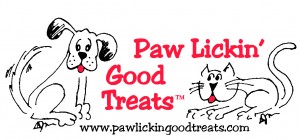Our mission at Paw Lickin’ Good Treats is to help people select food, treats, supplements, toys and accessories for their pets that will optimize health, happiness and well-being. We all want the best for our pets, but often pet owners are unsure as to which products are best for their needs. We are passionate about constantly educating ourselves and seeking out the best products available. In turn we strive to pass that knowledge to our customers. Knowledge is power.
We regularly get customers in the store who are seeking information about selecting the best food for their pets. Dogs and cats are individuals with their own special needs. There is no one food that is the best for all dogs and cats. That being said, it is clear that there are some general guidelines that set better foods apart from the less healthy options.
There are many options to consider when choosing a commercially prepared pet food. Some say that a frozen raw food is closest to dogs’ and cats’ natural diet. However, not everyone is comfortable with raw or can afford raw. Many people choose to combine a canned food with a dry kibble diet, but most people tend to feed a diet of primarily dry kibble. Dogs and cats can live healthy lives with any of these options as long as the food they consume consists of high quality ingredients. But how do you choose the best brands for your pet?
We have learned in recent years to carefully read the labels on the food we feed ourselves and our families. The wise pet owner will study the ingredients listed on the label of pet food as well. Begin by looking for a named protein source as the first ingredient. This can either be a specific meat or better yet a specific meat meal (the meal is the meat with the water content removed). Protein should be the majority ingredient in the food. Beware of labels that divide up grain sources to make it look as if meat is the main ingredient when actually the main ingredient is a variety of grains in different forms scattered throughout the list. Many dogs are allergic or sensitive to certain grains. We generally suggest avoiding corn, wheat, soy and gluten in food. The second most prevalent ingredient should be easily digested vegetables. One should always avoid bi-products, artificial preservatives and artificial coloring and sugar. Some people prefer to avoid grains all together and fortunately there are several grain-free options. Not every dog, however, needs to avoid all grains and there are many high quality foods that use such grains as barley, oatmeal, or brown rice as binders.
Unlike dogs, cats are true carnivores and therefore thrive on a diet of meat. Sadly, many cats spend their lives chronically dehydrated because they live on a diet of dry kibble that has many ingredients that are frankly unhealthy for a carnivore. Cats’ digestive systems are simply not designed to digest grains so a totally grain-free diet is best. In the wild, cats exist on eating prey that provides them with necessary water. This is not so for our domestic cats, which is why renal failure is one of the top medical problems from which cats suffer. We suggest feeding cats a diet that consists at least partially of a quality canned food. As with dog food, ingredients to avoid in cat food should include bi-products, artificial preservatives, artificial coloring, and sugar. Again, it is best to avoid all grains.
Basically, when deciding on a good food for your pet it is best to remember that health comes from the inside out. Whether your dog is itching, or simply lacking a zip in his step, changing his diet to include a holistic approach can often make a huge difference. And while you are at it, don’t forget that the same goes for treats. When selecting treats for your pets, it is best to avoid the same ingredients that you avoid in food. It all adds up!
We are happy to help you make a food selection that works for your pet!








